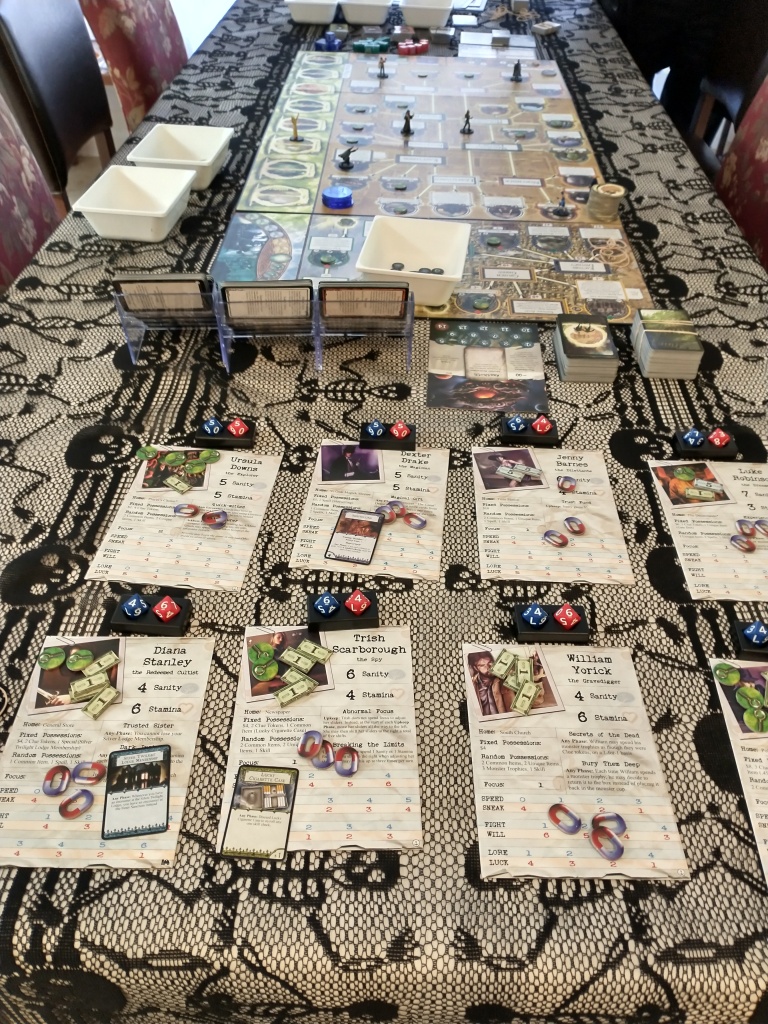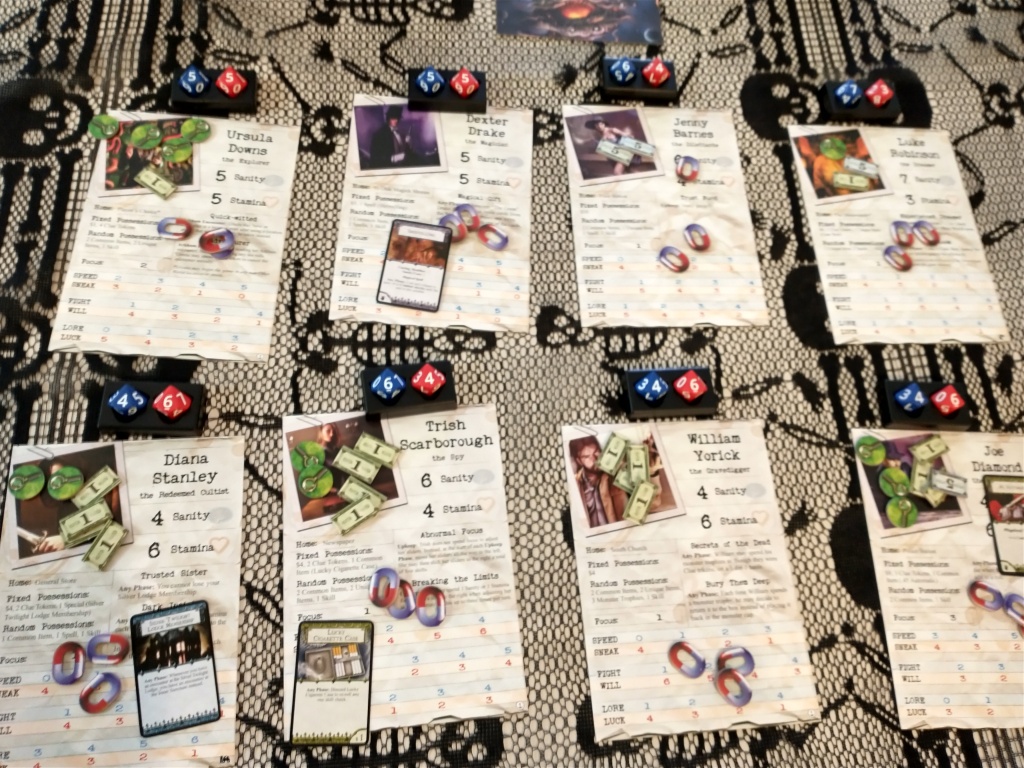
It was the waning moments of the year 1920, and a young man known as H.P. Lovecraft struck his pen to paper in what, unbeknownst to him, was to become a pivotal action for the future of board gaming. The Picture in the House, the first mention of Arkham proper, provided the precursor to many of Lovecraft’s tales. Now public domain, Lovecraftian horrors abound in books, movies, and games. Many of these fall flat, bemoaned by those consuming them as trite or uninteresting. The sheer quantity alone causes many to turn away.
However, one board game stands above the rest as the longest running board game featuring Arkham. Now owned by Fantasy Flight Games, Arkham Horror first edition spawned from Chaosium’s Call of Cthulhu roleplaying game in 1987. Today, we are on the third edition, which looks very little like its precursors. However, today I will review Arkham Horror Second Edition, since it is the game that is most recently on my mind.

Playing Arkham Horror involves a great deal of time, particularly in set up. First and foremost, assure that you have sufficient table space. Spread the board out, leaving plenty of room on all sides. Defeating the Ancient Old One and his monsters is never easy, and requires tons of components! To set up, you will need to lay out the 9 location decks, the gate deck, the mythos deck, the Ancient Old One sheet (and doom tokens, of course), the monster cup, the clue tokens, and the various tokens/markers related to gates. You will also need the various item and ally decks (separated out), the investigator card decks, your sanity and stamina tokens (if necessary-more on this later) and money tokens.
Each player chooses an investigator card. Here, we have decided that using the sanity and stamina tokens is not for us, and we use a red 10-sided die (d10) to denote stamina and a blue one to denote sanity, with the current sanity and stamina amounts face up. It is just one less piece to keep track of. Players receive their starting items (noted on the investigator cards) and place their character piece at the starting location noted on their investigator card. The players choose an Ancient Old One to battle (each has its own stats and requirements to defeat).

Clues are placed at each of the 11 unstable locations (red diamond) spaces on the board. These are locations where gates are most likely to open. Investigators are placed at their starting locations (also noted on their cards).
A mythos card is drawn and resolved, and the game begins with a chosen first player.
Game play is in five phases. At each phase, each player in clockwise fashion completes all necessary activities of that phase. Upkeep, which includes setting stats by moving their sliders the amount of their focus (unless character abilities dictate otherwise) and any other upkeep needs based on various item or investigator cards. During the Movement phase, each player moves their speed, unless they are in the Other Worlds (in which case they can move only to the next section of the Other World, regardless of movement). If a character is prone, they can only stand up this turn. Next, is the Arkham phase. Each character in a location (not on a street or in another dimension) will draw a card and have an event based on that location. Different locations have higher probability of certain types of events, which are depicted in icons on the locations, but it is no guarantee. Certain locations also have alternative other events that can be chosen, such as the hospital or shop, in lieu of drawing a card.

Once the Arkham phases is completed, the Other Dimension phase begins, and characters who are in Other Worlds will draw cards for their locations. These are based on colours rather than on actual locations. When they have completed their turns, the Mythos begins, with all monsters moving according to shapes on their tokens, and a card is drawn to determine what Mythos event will occur. This is very rarely good.
In fact, I have discovered that, when in doubt of the rules for Arkham 2e, go with whatever seems the least likely to be beneficial for the players, and that is likely to be the actual rule. And always beware being lost in Time and Space. Unless you’re a Dreamer. Then go there as much as you like.

Arkham Horror 2e strove to encompass the true essence of Lovecraft in a way at which other games have only teased. Expansions are available which make game play even more difficult and dismal for the players. Therefore, it is one of my favourite games of all time. Although this is an American game by Fantasy Flight, it has as many pieces and moving parts as many Eurogames and requires almost as much to keep up with the game play. Things can turn rather suddenly from “this is an easy win!” to “oh, wow, we’re all dead now.” There are many ways to lose, and only two real ways to win (only one if you choose certain Ancient Old Ones) –either close gates permanently or fight the Old One and win (except the ones where, once they awaken, you automatically lose).
This game has endless replayability, though expansions certainly add to the experience. Personally, I really enjoy cooperative games that have a high level of difficulty and a high likelihood of loss because I find them challenging and interesting. The writing for the cards and the story within is intriguing for those who enjoy Lovecraft and for those just starting out. My gaming group has also purchased the newer version of Arkham Horror, but it can hardly be called the same game. Many, many rules have been changed. The quality of the pieces is perhaps a little better in the newer edition, in my opinion, but I feel that my game shelf has room for both games. In addition, Arkham Horror can also be played as a single player game. I have spent many sleepless nights embracing the darkness by pulling this game out.

Although certainly not for everyone, Arkham Horror 2e is a great game for the gamer who likes a good story, high replayability, and a true challenge. The game scales very well for a single player and for up to 8 investigators (though time to play increases proportionately). It does have a high likelihood for an alpha player to take over if players are not cautious, however, and remembering that there is no one true avenue for success in this game, and there are countless avenues for loss, will be beneficial in ensuring that everybody gets to have their voice heard at the table is important. The miniatures are fairly high quality and fun to paint, as well.

Arkham Horror 2e is a classic game that has a place on many shelves. I highly recommend this game.
